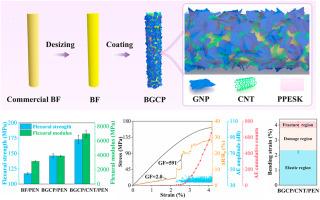Hierarchically structured basalt fiber reinforced poly (arylene ether nitrile) composites for enhanced mechanical, electrical, and damage self-sensing performance
IF 9.8
1区 材料科学
Q1 MATERIALS SCIENCE, COMPOSITES
引用次数: 0
Abstract
Basalt fiber reinforced polymer (BFRP) composites have been finding more applications in the aerospace, automotive, energy, and civil engineering sectors, driving demand for versions of such material with more advanced properties such as damage self-sensing. In this study, a novel multifunctional BFRP has been developed. Firstly, a hybrid coating composed of graphene nanoplate, carbon nanotube, and poly (phthalazinone ether sulfone ketone) was developed. The coating was then used to modify the basalt fiber, while additional carbon nanotubes were integrated into a poly (arylene ether nitrile) matrix. This hierarchical approach, combining micro-scale fiber surface modifications and nano-scale matrix reinforcements, significantly increases the mechanical performance of the BFRP, boosting tensile strength and modulus by 44.1 % and 26.4 % respectively, and flexural strength and modulus by 47.9 % and 121.3 % respectively. Finite element analysis and molecular dynamics simulation reveal that the thickened fiber-matrix interface and enhanced interfacial interaction contribute to these mechanical improvements. Furthermore, the hierarchical structure elevates electrical conductivity from an insulating state to 7.0 × 10−4 S/m with only 0.9 wt% nanofillers, while enabling damage self-sensing functionality. The composite exhibits a high sensing sensitivity (gauge factor = 591) during the damage stage and an excellent cyclic stability during the elastic stage. Notably, enhanced self-sensing sensitivity at elevated temperatures was observed, highlighting the composite's potential for high-temperature applications. The presented work provides an effective solution for developing multifunctional BFRP with enhanced mechanical, electrical, and damage self-sensing properties, making such material suitable for a wide range of demanding applications such as structural-functional integrated load-bearing components.

层次结构的玄武岩纤维增强聚(芳醚腈)复合材料,增强机械、电气和损伤自感知性能
玄武岩纤维增强聚合物(BFRP)复合材料在航空航天、汽车、能源和土木工程领域得到了越来越多的应用,推动了对具有更先进性能(如损伤自感知)的材料的需求。本研究开发了一种新型多功能BFRP。首先,制备了由石墨烯纳米板、碳纳米管和聚酞嗪醚砜酮组成的杂化涂层。然后使用涂层修饰玄武岩纤维,同时将额外的碳纳米管集成到聚(芳醚腈)基体中。这种将微尺度纤维表面改性和纳米尺度基体增强相结合的分层方法显著提高了BFRP的力学性能,拉伸强度和模量分别提高了44.1%和26.4%,弯曲强度和模量分别提高了47.9%和121.3%。有限元分析和分子动力学模拟表明,纤维-基体界面的增厚和界面相互作用的增强有助于这些力学性能的提高。此外,分层结构将电导率从绝缘状态提升到7.0 × 10−4 S/m,仅使用0.9 wt%的纳米填料,同时实现损伤自感知功能。该复合材料在损伤阶段具有较高的感知灵敏度(测量因子= 591),在弹性阶段具有良好的循环稳定性。值得注意的是,在高温下观察到增强的自传感灵敏度,突出了复合材料在高温应用中的潜力。本研究为开发具有增强机械、电气和损伤自感知性能的多功能BFRP提供了有效的解决方案,使这种材料适用于广泛的要求苛刻的应用,如结构-功能集成承重部件。
本文章由计算机程序翻译,如有差异,请以英文原文为准。
求助全文
约1分钟内获得全文
求助全文
来源期刊

Composites Science and Technology
工程技术-材料科学:复合
CiteScore
16.20
自引率
9.90%
发文量
611
审稿时长
33 days
期刊介绍:
Composites Science and Technology publishes refereed original articles on the fundamental and applied science of engineering composites. The focus of this journal is on polymeric matrix composites with reinforcements/fillers ranging from nano- to macro-scale. CSTE encourages manuscripts reporting unique, innovative contributions to the physics, chemistry, materials science and applied mechanics aspects of advanced composites.
Besides traditional fiber reinforced composites, novel composites with significant potential for engineering applications are encouraged.
 求助内容:
求助内容: 应助结果提醒方式:
应助结果提醒方式:


